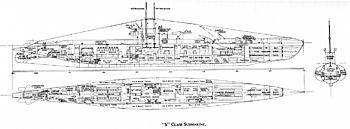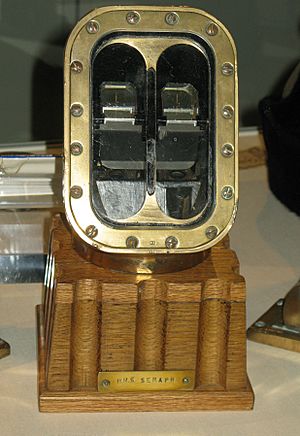HMS Seraph (P219) facts for kids

HMS Seraph
|
|
Quick facts for kids History |
|
|---|---|
| Name | Seraph |
| Namesake | Seraph |
| Ordered | 23 June 1940 |
| Builder | Vickers Armstrong, Barrow-in-Furness |
| Laid down | 16 August 1940 |
| Launched | 25 October 1941 |
| Commissioned | 27 June 1942 |
| Decommissioned | 25 October 1962 |
| Identification | Pennant number: P219 |
| Fate | Scrapped |
| Badge | |
| General characteristics | |
| Class and type | S-class submarine |
| Displacement |
|
| Length | 217 ft (66.1 m) |
| Beam | 23 ft 9 in (7.2 m) |
| Draught | 14 ft 8 in (4.5 m) |
| Installed power |
|
| Propulsion |
|
| Speed |
|
| Range | 6,000 nmi (11,000 km; 6,900 mi) at 10 knots (19 km/h; 12 mph) (surfaced); 120 nmi (220 km; 140 mi) at 3 knots (5.6 km/h; 3.5 mph) (submerged) |
| Test depth | 300 ft (91.4 m) |
| Complement | 48 |
| Sensors and processing systems |
|
| Armament |
|
HMS Seraph (P219) was a special submarine built for the Royal Navy during World War II. Launched in 1942, she became famous for her secret missions and spy work. One of her most famous missions was called Operation Mincemeat. After being built, Seraph was sent to the Mediterranean Sea. There, she was chosen to carry out many important special operations.
Contents
About the Seraph Submarine
The Seraph was an S-class submarine. These submarines were made to patrol in places like the North Sea and the Mediterranean Sea. The Seraph was part of the third group of S-class submarines, which were a bit bigger and better than the earlier ones.
Submarine Size and Crew
The Seraph was about 217 feet (66.1 m) long. She was 23 feet 9 inches (7.2 m) wide and went 14 feet 8 inches (4.5 m) deep in the water. When on the surface, she weighed about 865 long tons (879 t). When she was underwater, she weighed about 990 long tons (1,010 t). The submarine had a crew of 48 officers and sailors. She could dive down to 300 feet (91.4 m) deep.
How the Submarine Moved
On the surface, the Seraph used two powerful diesel engines. These engines helped her move at a speed of 15 knots (28 km/h; 17 mph). When underwater, she used two electric motors, which allowed her to go about 10 knots (19 km/h; 12 mph). She could travel a long way without needing to refuel.
Weapons and Equipment
The Seraph was armed with seven 21-inch (533 mm) torpedo tubes. Six of these were at the front, and one was at the back. She also carried extra torpedoes. Besides torpedoes, she had a 3-inch (76 mm) deck gun. She also had a 20 mm Oerlikon AA gun to shoot at planes. For finding things underwater, she had an ASDIC system, which is like sonar. She also had radar to spot things on the surface.
Secret Missions of the Seraph
The Seraph was known for her many secret and important missions during the war.
Operation Flagpole: A Secret Meeting
Seraph first helped with Operation Torch, which was when the Allies landed in North Africa. Her first job was to use her periscope to scout the coast of Algeria in September 1942.
After that, Seraph was chosen for Operation Flagpole. This mission involved secretly taking important people to North Africa. She carried General Dwight Eisenhower's deputy, Lieutenant General Mark W. Clark, for secret talks with French officers. The submarine was loaded with collapsible canoes, submachine guns, and walkie-talkies. General Clark and his team were dropped off on the Algerian coast on October 20, 1942. This meeting was very important because it helped reduce French opposition to the Allied landings. Seraph picked up the group a few days later and took them back to Gibraltar.
Operation Kingpin: The Submarine with Two Captains
On October 27, Seraph was sent on another secret mission. She had to pick up French General Henri Giraud and his staff from the coast of southern France. General Giraud was going to meet with Eisenhower in Gibraltar. The goal was to get the French forces in North Africa to support the Allies.
There was a problem: General Giraud did not want to deal with the British. Since there were no American submarines nearby, HMS Seraph pretended to be the "USS Seraph". She even flew the US Navy flag! An American captain was put in charge, but the British captain, Lieutenant Commander Jewell, still ran the submarine. The British crew even tried to speak with American accents, like in the movies! But General Giraud knew it was a trick.
After picking up the general, Seraph transferred them to a PBY Catalina flying boat on November 7. Later that month, Seraph went on her first war patrol. She helped carry American and British soldiers for scouting missions. In December 1942, she damaged an Italian merchant ship. She also accidentally hit a German U-boat, which damaged both submarines. Seraph then had to go back to Britain for repairs.
Operation Mincemeat: The Dead Spy
Seraph returned to England for repairs in January 1943. A few weeks later, her captain, Jewell, learned about Operation Mincemeat. This was a very clever plan to trick the Germans. It was part of a bigger plan called Operation Barclay. The goal was to make the Germans believe the Allies would invade Greece and Sardinia, not Sicily.
On April 19, Seraph set sail again with a very unusual "passenger." This was a dead body placed in a metal container, packed with dry ice. The body was dressed in a Royal Marines uniform. Attached to the body was a briefcase filled with fake "secret documents." These documents were designed to mislead the Germans.
In the early morning of April 30, Seraph surfaced near the coast of Spain, close to Huelva. Captain Jewell and his officers carefully put the body and briefcase into the water. They then sank the metal container in deeper water. Jewell sent a radio message saying "MINCEMEAT completed," and the submarine continued to Gibraltar. The Spanish found the body and thought it was a courier who died in a plane crash. The fake documents were passed to the Germans. This trick worked! The Germans moved their forces away from Sicily, which helped the Allies invade Sicily more easily.
More Missions and Training
By late April 1943, Seraph was back in the Mediterranean. She tried to attack several enemy ships but was not always successful. She was depth-charged a few times but was never badly damaged.
In July, during the Allied invasion of Sicily, she helped guide the invasion fleet. For the rest of 1943, Seraph continued to fight German and Italian forces. She attacked several convoys but only sank a few small ships.
Becoming a Training Submarine
In December 1943, Seraph went to Chatham for more repairs. In March 1944, she had an accident during her last patrol in the English Channel. After this, it was decided to change her into a training boat. She would be used to practice anti-submarine warfare.
The Royal Navy had learned about new German U-boats that could go very fast underwater. These new XXI-class U-boats were a big threat. So, Seraph was quickly changed to be very fast underwater too. This way, the Navy could practice new ways to fight these fast enemy submarines.
To make her faster, parts on the outside of her hull were made smoother. Her bridge was made smaller, and her gun and one of her periscopes were removed. Her motors were made stronger, and she got better batteries. She also got new propellers.
In September and October 1944, Seraph was used for trials and training. This helped the Navy learn how to deal with the new, fast underwater threats.
After the War Years
Seraph stayed in service even after the war ended. In 1955, she was covered with armor and used as a target for torpedo practice. She was part of a group commanded by her first captain, who was now Captain David Jewell.
Seraph also appeared in a British movie called The Man Who Never Was (1956). This movie told the story of Operation Mincemeat. You can see her identifying marks in some parts of the film.
She remained in service until October 25, 1962. This was exactly 21 years after she was first launched.
When she was taken apart for scrap metal on December 20, 1962, some parts of her were saved. Her conning tower and a torpedo loading hatch were kept as a memorial. They are at The Citadel in Charleston, South Carolina, in the United States. This monument is special because it is the only place in the United States where the Royal Navy flag is allowed to fly permanently. It flies next to the US flag to remember the great teamwork between Britain and America during World War II.
Images for kids





